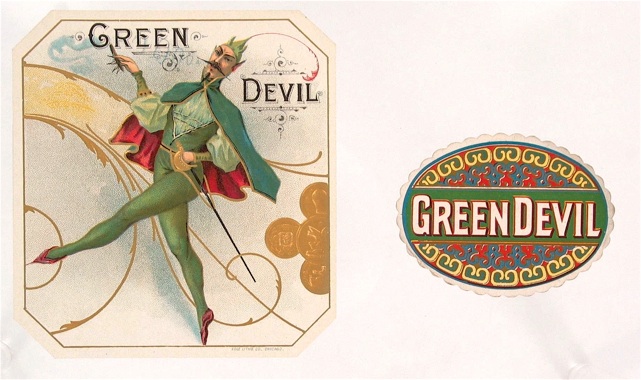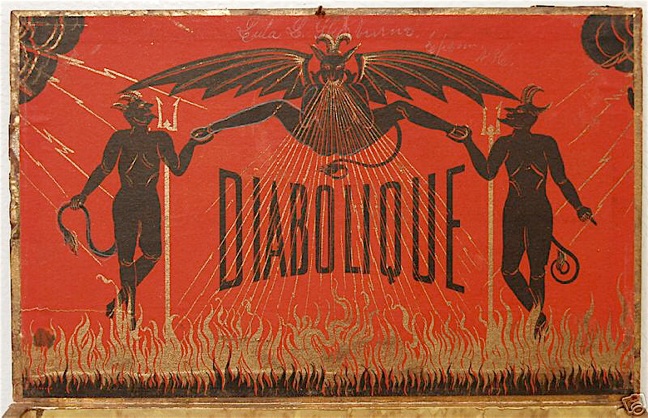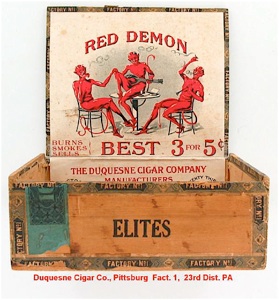The Devil Made Me Buy It !
A National Cigar Museum Exhibit
© Tony Hyman
Uploaded: August, 2007
Latest addition: May 3, 2010
Text & format modified: May 19, 2010

The Devil Made Me Buy It !
A National Cigar Museum Exhibit
© Tony Hyman
Uploaded: August, 2007
Latest addition: May 3, 2010
Text & format modified: May 19, 2010
Although experimentation with cigar label images and phrases began as early as the 1830’s in Cuba, cigar labels in the U.S. remained uninspired until the boom in cigar smoking after the Civil War.
What went on in Cuba seems to have had little impact on the advertising of the United States. Philosophic differences between manufacturers in the two nations led to entirely different development of their industries. From the beginning, Cuban cigar makers were export minded. Although half of Cuban production was smoked at home, export was where the big bucks were. Export required building brand name recognition and reputation. Successful export business depended on customers developing loyalty to a single product. Certainly Cuban companies made custom brands, but far more often marked boxes of their own brand as “Custom made for” a particular wholesaler, retailer or smoker. In the U.S., it was entirely different.
Export was never a concern of U.S. cigar factories, most of whom were serving a local clientele. The rest of the world didn’t particularly want U.S. made cigars, but Americans sure did. In a huge ever-expanding country there were rarely enough cigar rollers to go around. U.S. production was ten, twenty, thirty times the number of imported cigars.
Because of the way cigars passed through distributors, wholesalers, jobbers, etc. there was seldom, almost never, concern for brand identification. Most domestic cigars were sold under local and regional private labels. In the independent-minded U.S. everyone wanted their own brand. And everyone had them. Many factories made only “for the trade” offering no brand of their own, manufacturing whatever they were asked. The huge insatiable market that was this country asked for every sort of brand and image imaginable. With so many customers, and no precedents to proclaim the marketing power of women, children, puppies, greed, health and happy home themes, cigar men and printers tried everything in the search for what would sell. True, some themes, like pretty girls, celebrities, heroes and landmarks are obvious choices in any culture. Others were less obvious. Demand for the unique, something that stood out, raised the Devil.
1913 RED DEMON
c1895 THE DEVIL CIGAR advertising clock
1920’s GREEN DEVIL
European MEFISTO & MEPHISTO
c1915 untitled European Devil
1911 SATEN CIGAR
1883 LITTLE SATAN
Smoking demons seem to be using their cigars as transportation like rockets in this odd early illustration.
This sloppily-applied 1870’s style label was used in the early 1880’s by Missouri 4th District Factory 28. Owner and customer unknown.
[5731]
1883 LITTLE IMPS
1879 DIABOLIQUE
1879 Seems to have been a good year for demon spawn if the cigar world is any measure. This box, too, is entirely paper covered, tho edged traditionally. Front, back, top, inside lid and ends all have different labels.
Cigars by Foster-Hilson whose 700 rollers were at 39th & 1st Ave.
Customer unknown.
[10231] [10234]
[10233]
Inner label of box in less faded condition than the example in the NCM collection. [w0213]
1879 BEELZEBUB
















c1900 Kadee Cigarettes “mechanical” devil


c1900 Salesman’s sample inner and outer labels
This inner and outer set is the typical way labels were offered as samples by American printers. This label has not been found actually used on a box.
SOLD; no longer part of the NCM.
[T-88-11]

European Demon
‘
As demonic a character as you’re likely to see on a cigar
label, his grin is not one of pleasure. Although believed European, this recently purchased set of unused labels may have been intended for boxes in any Spanish-speaking country.
Would you really buy a cigar considered appropriate for the Emperor of Hell? What’s their slogan? “For that fiery taste you enjoy?”
[16297] [16298]


Nothing like demons, Hell-fire and eternal torment to make you want to smoke. Literally.
Cigars by Sutro & Newmark, made in their giant factory which employed 1,000 rollers at 73rd Street & 2nd Avenue in NYC. Client unknown.
In my opinion, this box, which is entirely paper covered and without edging is one of the most creatively labeled cigar boxes of the late 1870’s.
[8775]
[8777]
Someone doesn’t know how to spell, but the image is unmistakable even without the Hell-fire of other brands.
The name was registered in 1893 and this box was used in 1911 so there was plenty of time to catch the error, but everyone was apparently happy.
Cigars were made by A.E. Bender, 44 Green St. in Albany, NY for an unknown customer.
[9870]
Comic Devils are not common, though when one shows up it is almost always on a European label like seen here. This selfish Devil, unwilling to share his cigars, is a gem of European design. Whether it was intended as an inner or a flap is unknown.
[8345]
Two 20th century inner cigar labels.
MEFISTO is one of the more attractive art deco style labels. I’d love to see it on a box as intended. Pre WWII European boxes don’t often turn up in the US but thanks to eBay are becoming more available.
MEPHISTO is rather plain and may be the label for the brand advertised in the business card below. It is nearly always impossible to know who used a loose label, where, and when.
Card below not in the NCM collection.
Dramatic clock advertising THE DEVIL CIGAR. The brand was sold around the turn-of-the-century in the U.S.
Despite the comedic giant cigar, this Demon is more in the classic mode than his green namesake seen above. Wings, forked tail, cloven hooves, horns and pitchfork are all part of the Western view of the Prince of Dark.
The “Devilish Good Smoke” is a natural slogan.
A cigar box of these sold on eBay, but alas I was underbidder, unable to bid higher due to shortage of capital.
Size: 11.5” by 13.5”.
[10453]
Three comedic demons adorn this c1910 box used by Pittsburgh’s Duquesne Cigar Co. (Fact. 1, 23rd tax district). All three demons smoke cigars while two play musical instruments. The cigars “Burn, Smoke, Sell Best,” the box claims.
This box of 100 pencil thin cigars isn’t much bigger than the standard NW 50/10.
[12949]
Yes, it advertises cigarettes and not cigars, but this happy jaunty demon is also an eye-catching piece of advertising you’re not likely to see anywhere else.
Approximately 18” high, he’s jointed at the left shoulder and elbow as well as both legs permitting him to be posed in a variety of positions. Note the hook atop the umbrella for a nail to hang it on the wall.
SOLD so no longer part of the NCM.
[T-88